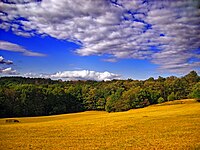
Photo from wikipedia
Abstract One target of biological conservation is the protection of biodiversity in agricultural landscapes. However, in their land-use decisions, farmers are often challenged with balancing biodiversity maintenance and profit generation.… Click to show full abstract
Abstract One target of biological conservation is the protection of biodiversity in agricultural landscapes. However, in their land-use decisions, farmers are often challenged with balancing biodiversity maintenance and profit generation. Under the current agricultural system, this tends to result in intensive farming which destroys suitable habitat for wild species. Thus, the potential for land-use conflicts between agriculture and biological conservation is high. Previous studies that investigated the effects of subsidies and taxes suggest mild trade-offs between conservation and farming, thus favouring land-sharing solutions to biological conservation. However, many ecological-economic models that dealt with this issue neglect possible Allee effects, which have been found by ecologists to be a common phenomenon. The existence of Allee effects markedly alters predictions of ecological-economic models: we show that conservation success is accompanied by substantial losses in agricultural production. More suitable habitat is required to prevent extinction of the species of interest, and conservation measures should start before the population has declined to some critical value. We emphasize the effect of spatial fragmentation on population viability under an Allee effect, as a clumped area of suitable habitat protects a population much better from extinction than a fragmented mosaic of habitat patches.
Journal Title: Ecological Modelling
Year Published: 2020
Link to full text (if available)
Share on Social Media: Sign Up to like & get
recommendations!